The southern Marmara region began to be of importance to the Byzantines in the 6th century as the demand increased for grapes, salt, grain and wood suitable for shipbuilding. The harbour at Trilye was one of those to be modernised as trade and the associated population increase made this a flourishing town.
Several churches were built at this time, including the impressive Church of St Theodore (40.393064, 28.796805). The area became a monastic centre with remains of some surviving, notably Hagios Sergios and Hagios Ioannes Theologos (Aya Yani).
The area experienced a boost in importance after the Latin conquest of Constantinople in 1204 and the subsequent rise of the Empire of Nicaea. Trilye continued to grow after the return of the Byzantine capital to Constantinople in 1261. The Church of Panaghia Pantobasilissa (40.393302, 28.795397), generally known as Kemerli Kilise (The Arched Church), appears to have been built in the early 14th century.
The Ottomans officially conquered the Trilye region in 1323. This was probably not a tremendously dramatic event as Turks had been settling there for some decades and the area continued to be essentially Greek in character until the early 20th century. Osman Gazi, the Ottoman leader, was not given to wasting perfectly good buildings. The Church of St Theodore became the Mosque of the Conqueror (Fatih Camii) and remains in good condition.
Trilye became a thriving Christian town in a Muslim empire. The citizens seem to have kept quiet, paid their taxes and become unobtrusively wealthy. Most of what is observable in the current time comes from this Ottoman Greek period, particularly the distinctive wooden houses and solid stone churches. Several of the churches of the 18th and 19th century include identifiable Byzantine elements in their structures.
The most impressive building in town comes from the last years of the Greek period. This is the Zarifeion School (Taş Mektep) a huge neo-classical thing that is currently preserved in a state of dereliction. The rakı-drinking clientele of the excellent Vedat’in Yeri told me that one of the alumni of the Zarifeion was Archbishop Makarios of Cyprus. These gentlemen also alerted me to the presence of the Church of the Archangels in neighbouring Kumyaka.
The exchange of populations that cemented the Republican era in Turkey was probably less traumatic for the Greeks of Trilye than for those from other parts of Turkey. A shipping businessman named Phillipos Kavounidis was able to organise the transport of the population to the Rafina region of Greece, where their descendants still live. They were replaced by a much smaller number of Turks from the Salonica area. These people seem to have adjusted to life in their pretty seaside town. Some fish, some produce a lovely selection of olive oils and an increasing number cater for tourists. There must have been a BMC dealership here in the 1970s because there is a high density of Austin-Leyland and Morris-Leyland tractors that I have not seen in the rest of Turkey. The Republicans’ Turkification policy resulted in a name change from Trilye to Zeytinbağı. Nobody in town seems to use the Turkish name.
Fatih Camii, Church of Christ and St Stephen, Church of St Theodore, Agios Stephanos
This is a nice typical cross-in-square church from the early decades of the 8th century. It has one narthex and a porch, supported by four solid columns with basket capitals that hint of something far more substantial atop them than the wooden roof in place today. The whole thing is a lot like Kocamustafapaşa Camii (St Andrew in Krisei) must have looked before its many restorations.
With Turkish rule came the inevitable mosque conversion although this seems to amount to little more than the addition of a mihrab, a mimber and some pleasing woodwork that marks the area for women. A pleasant hamam was added to the complex in the early 16th century. Bits of Byzantine marble scattered about the site hint at the buildings that once surrounded the church. The ironwork that would permit a muezzin access to the minaret is comically decrepit. Presumably, the incumbent contents himself with a CD of the ezan broadcast through the speaker horns that adorn the minaret balcony.
The building may or may not have been reconverted to a church during the Greek occupation of 1920-1922. This article provides an entertaining account of the stories that have sprung up about this period.
Kemerli Kilise, Panagia Pantabasilissa, Church of Mary, Queen of All
This is a much later church than Fatih Camii. It was built in 1336, about the same time that the Orhan Gazi Mosque was going up in nearby Bursa. This gives an idea of how close to the end of Byzantine rule it was. It was the second of Trilye’s churches and was presumably built in response to an increase in the congregation, probably an influx of refugees from Ottoman occupation in neighbouring districts. The church forms a sort of elongated cross-in-square, having six columns rather than the usual four.
Mango and Ševčenko (1973) saw similarities between the Panagia Pantabasilissa and churches built a few years previously in Mistra, in the Peloponnese. They concluded that the unusual style represented an importing of ideas from this new flourishing of the arts further west. Çağaptay (2011) notes similarities with the exuberant brickwork of earlier buildings in Bithynia and points out that the abundance of assorted columns available for reuse may have lent themselves to the rapid construction of a much-needed large space for worship. The resulting melange of columned basilica below and cross-in-square above may have developed without influence from Greece.
The church was never converted into a mosque – the church of Agios Stephanos seems to have met the needs of the Muslim population. It appears to have been well-maintained until its abandonment when the Greek population was forced to leave in 1923. It has stood since then without any restoration. The outer walls contain a lot of marble pieces from earlier buildings, giving a few archaeological clues to the pre-Byzantine past of the town. The arches that give the church its familiar name of Kemerli Kilise are not only part of the main structure, they stretch from the church itself across two adjacent streets.
The interior of the church bears remains of several layers of substantial fresco decoration. The first major painting is from the 14th century, immediately after construction; the last from around 1723. The accumulated damage of earthquake and neglect have opened the church to the weather and the frescos are disappearing.
The neighbouring houses nestle against the church. The house on the northern side has incorporated the church façade into a terrace. The family across the road on the southern side has a grapevine growing in the stones of the building and uses the shade of the church as a pleasant summer seating area.
The church was privately owned for a while. With the whole town under a preservation order by the Ministry of Culture, I imagine that it would be difficult to do anything to the building that could be useful to an investor. In any case, the Constantinople Patriarchate bought it back in 2013. It remains to be seen what the official Orthodox plans are for Panagia Pantabasilissa.
The two main churches of Trilye embody the essential dichotomy facing Byzantinists seeking to preserve ancient buildings. Fatih Camii is in far better condition because of regular maintenance, but has been altered so much that is only a little like the church it once was. Kemerli Kilise is dilapidated and vulnerable to further damage but gives a much clearer impression of what it was like as a church.

Categories: Uncategorized | No Comments »





















